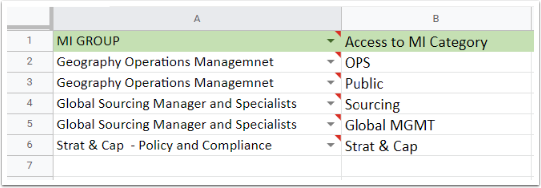This article describes how to use a spreadsheet to strategically onboard content to Metric Insights in a more efficient and organized way.
The example spreadsheet is used as a mapping tool to helps Administrators add content to the MI application. The spreadsheet can help to understand which Elements have been onboarded to completion and which may still need work.
Here you can find and example spreadsheet in Google Sheets. Duplicate it to your Drive or download as an XLSX or ODS file to your PC.
NOTE: When you start to use the table to onboard the content, all necessary Data Sources should be set up.
General Information
The example file contains several tabs. All of them, as well as the column names in all the tables, are optional. You can delete them if they don't fit your needs and add as many new ones as you like.
Below is a review of the suggested tabs and the example columns of the table.
Content Tab
This tab is an inventory of objects. Use the tab to list all the Elements (tiles) – Metrics, Dashboards, Reports, etc. – to be added to the Metric Insights application.
Column descriptions:
- Content: Name of and object
- Tool: The platform where that object is sourced
- Object Type: Type of object defined in source (e.g dashboard, live dashboard, PDF, etc.)
- URL: The address of an object
- Location: The folder or project within the Tool where the object is stored
- MI Category: The Category within Metric Insights in which the object has to be placed
- Tags: Keywords or glossary terms (if applicable) which can make searching for content easier
- Folders: The Folders within Metric Insights system (optional)
- Update Interval: How frequently the object needs to be updated
- Recertification: How often the object undergoes certification within a publishing workflow (if applicable)
- Business Owner: Regular, Power User, or Administrator responsible for answering business-related questions
- Technical Owner: Power User or Administrator responsible for answering technical questions
- Data Steward: Regular, Power User, or Administrator that is a Data Steward of the object
Data Steward, Business and Technical Owners are Users that exist in Metric Insights. For more details about the difference between those check What Types of Users Exist in Metric Insights? article.
Categories Tab
In this tab you can list all the Categories that have to be created within Metric Insights application.
Every Element within Metric Insights must be associated with a single Category. When "Access to Element" is mentioned it means an access to all Elements within a Category.
Column descriptions:
- MI Category: The name of the Category to create in MI application
- Category Business Owner: The name of the User that is a Business Owner of the Category
- Category Technical Owner: The name of the User that is a Technical Owner of the Category
- Is Category Auto Synced: Is the Category used as the target/destination for a Data Source using auto-sync (optional)
- Synced From Tool: Plugin association with related Data Source (if auto-sync is used)
- Synced From Location: Used to further specify location of content (within Data Source, within workbook, from other Category within publishing workflow, etc.)
- Publishing Workflow: To which Publishing Workflow this Category belongs. To learn more about Publishing Workflows check this article
For more details about difference between Technical Owner and Business Owner check What Types of Users Exist in Metric Insights? article.
Category Access Tab
Here you list the Groups within Metric Insights and define to which Categories those Groups will have access.

NOTE: MI GROUP column lists the Groups within Metric Insights only.
Personas Tab
In this tab you can list the types of Users (by role, identity, function, etc.) that will be working with the Metric Insights instance.
A persona is a pretended User for the purposes of confirming User access to content and functionality. In example, you may consider a Sales persona mapped to a sales group in AD which has access to all content in the sales category across multiple platforms of inventory.
Column descriptions:
- Persona: The name of the Users type
- LDAP Group: The Distinguished Name of the Group in LDAP to which the persona may belong
- MI Group: The name of the Metric Insights Group associated with Persona
- Access/Privileges Set: The Privileges Set applied to the Users of chosen type (optional)
Portal Pages Tab
In this tab you can store the list of Portal Pages that need to be created.

Column descriptions:
- Page Name: Name or internal name of a Portal Page object in Metric Insights
- Persona: The name of a persona from related tab
- Start Page: Indicate if this Portal Page will be a Start Page instead of the catalog
Privilege Sets Tab
Privilege Sets are complex and must be configured directly on Metric Insights. This tab can be used to generally define what Privileges that Privilege Set enable. For more details about different Privileges check Privilege List.
Users Tab
In this tab you can define a list of pilot Users that can be used to confidently confirm the right feature, functions, and accessible content within the Metric Insights application.
Column descriptions:
- Persona: Persona (as defined in other tabs) associated with a specific User
- Last Name: Last name
- First Name: First name
- Email Address: Email address
- Network User ID: User's ID in the network
- Region: The region the User is working from (if applicable). If features, functions, and content are subdivided, add columns for the purposes of validation.
- User Type: The type of the User within Metric Insights system
For more details about User types check What Types of Users Exist in Metric Insights? article.





